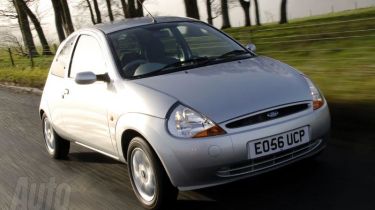Ford Ka Hatchback (1996-2008) review
Over a decade young and still going strong: the Ford Ka is one car that’s lived longer than anyone could have expected when it first appeared in 1996.

Over a decade young and still going strong: the Ford Ka is one car that’s lived longer than anyone could have expected when it first appeared in 1996. An all-new version arrives later this year, but the charming original is still worth a look.
Styling/Image
When the distinctive shape of the Ka first hit the streets it caused quite a stir. But despite becoming a familiar sight on UK road, the curves and sharp creases of the small Ford’s bodywork mean it still stands out from the crowd. Newer cars get body-coloured bumpers, while entry models still feature the unpainted black plastic items of the early versions. The range topping SportKa gets a chunky bodykit and larger alloy wheels.
Interior/Practicality
Throughout its life, the Ka’s interior has remained largely unchanged. While the dashboard design is eye-catching, the plastics feel cheap and occupants in the rear will find the cabin cramped. The entry-level Studio is sparsely equipped, but does get power steering. Pay a little more for the Style and you’ll get body-coloured bumpers, electric windows and a CD player. Air conditioning and a heated windscreen appear on the Style Climate
Engine/Performance
Just two engines are available in the Ka line-up. The entry-level 1.3-litre unit can trace its roots back to the Fifties and can only muster 69bhp. It gets thrashy when extended, but strong low rev torque makes it perfect for nipping around city streets. The SportKa is a genuine junior hot hatch and gets a 94bhp 1.6-litre powerplant. Buyers wanting a diesel option will have to wait for the next generation car.
Driving Experience
The Ka is great fun to drive, whichever model you choose. Direct steering and strong grip combine to give the smallest Ford supreme agility and bags of driver feedback. Better still, the ride is composed and comfortable, making the car a surprisingly capable motorway cruiser. But the Ka can’t disguise its age when it comes to refinement. Engine, road and wind noise all make their presence felt at higher speeds.
Costs
Buy a Ka and you can expect low running costs. The 1.3-litre versions represent the best bet for buyers on a budget, setting you back as little as 31 pence per mile to run. Add another 10 pence to this figure if you fancy the racy SportKa. The only financial downside is poor residuals. The smaller engined versions will struggle to retain 27 percent of their value after three years.
Safety/environment
Although not quite as sturdy as modern equivalents, the Ka is still a fairly safe place to be, with a three star EuroNCAP rating. A driver’s airbag and ABS are standard on all models, while the optional Reflex Pack adds another three airbags – one for the passenger and two side items. Sadly, the CO2 emissions are disappointing for such a small car. The 1.3-litre unit produces 147g/km, while the SportKa puts out 182g/km
Our Choice: Ka Style Climate







